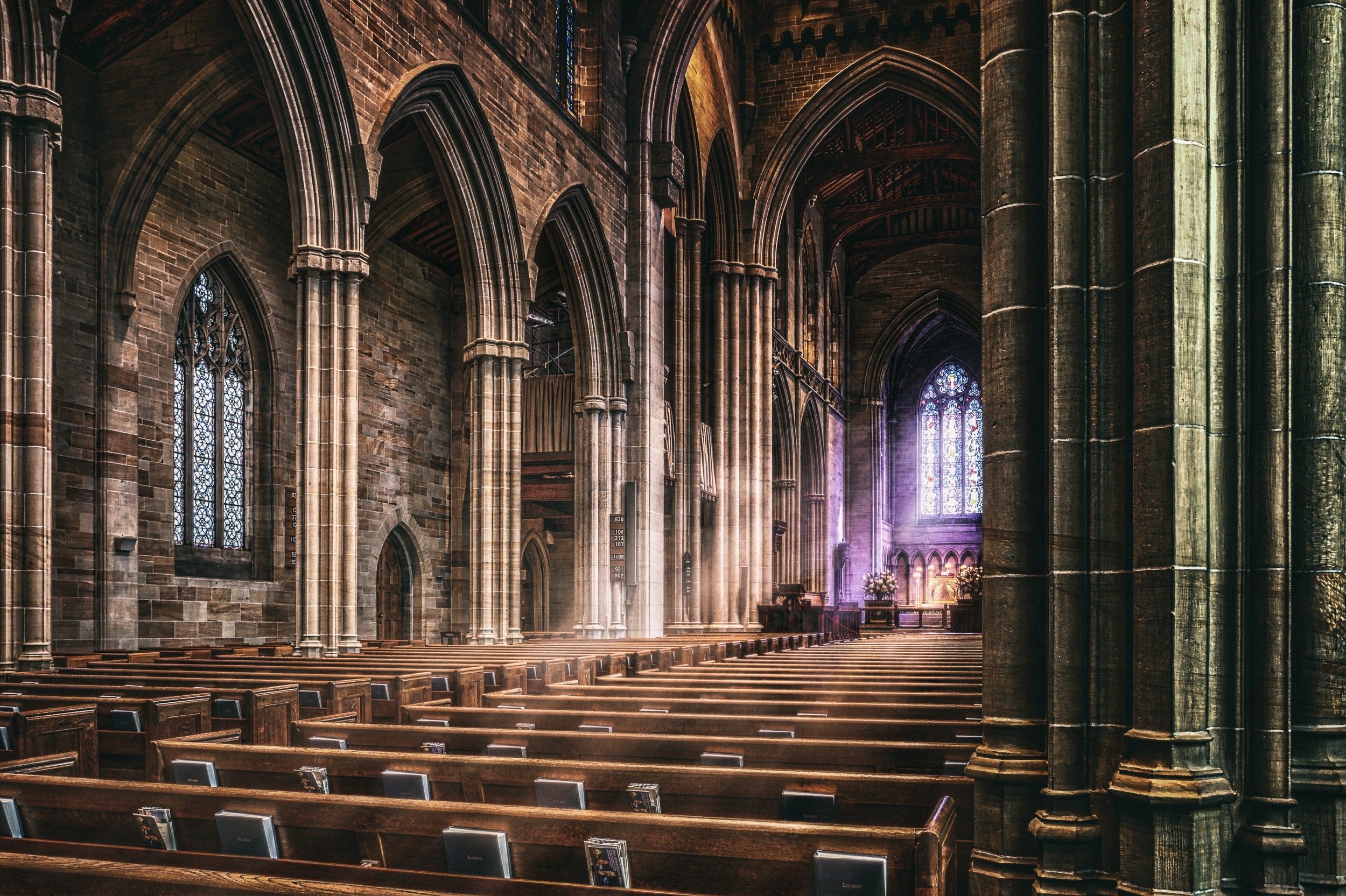A Meditation on Sacred Spaces
November 26, 2021 | By Bella Gamboa JE ‘22
Pictured: light shining into an empty cathedral
Limestone columns rise to an intricately engraved ceiling far above, whose artistry is somewhat shadowed as it lies above the lights that line the sanctuary. The nave is imposing yet familiar; its grandeur feels like home. The stained-glass windows are particularly exquisite: the cool blues and purples that enclose a stone brought from the moon, the panoply of shades in the rose windows, the vivid panes painstakingly joined by lead seams. The light filtering through the glass creates puddles of color, rivulets of crimson and gold, eddies of amber and sapphire. And these are but the wonders of the main sanctuary; both outside and deeper within, crevices and cornices, chapels and gargoyles, add to the intricacies and spectacle of the church.
Starting when I was four years old, I had regular school chapel services in this building: the Washington National Cathedral. At first, we met in St. Joseph’s Chapel, where we sat near the burial place of Helen Keller and beheld a painting of the crucified Christ being carried to the tomb by his grieving companions, His halo gilt and shining. Later, we would graduate to the main sanctuary for weekly services, and I became deeply familiar with the patterns of the stonework floors that greeted me every Friday for years.
Although I grew up in the shadow of the sixth largest cathedral in the world, the churches I have attended with my family and on my own in college have been much simpler. An unadorned semicircular sanctuary, a high school gymnasium, a former parking garage that was renovated to serve as a church in space-scarce Manhattan. These places, too, have housed the communities that are my spiritual homes. In the last year, the locations shifted more drastically—to my own bedroom, to the New Haven Green.
These settings could not be more disparate. But I have been struck by how God has been present in different but delightful ways in each of these spaces, from the lofty gothic architecture in DC to the white walls of an apartment on Dwight Street. As the architect Roberto Chiatti notes, “The first and most important thing about church design is that it must help worshipers to become re-enchanted with the glory of God’s creation.” I have found that the glory of God’s creation is present in these sometimes unexpected places.
Most recently, worshipping on the New Haven Green this fall was unexpectedly enjoyable. The sky might be an even more glorious ceiling than that of a cathedral; in its vastness, it reminded me that God Himself “determines the number of the stars; He gives to all of them their names” (Psalm 147:4). And just as He made and knows the stars and provides for all the birds (and maybe even the squirrels) on the Green, He knows and cares for each person at the service, each person in the city of New Haven, and everyone beyond that fairly small scope (Matthew 6:26). The splendor of the Green was not uncomplicated—I confess that at times I felt squeamish and feared the judgment of passersby. But even in the strangeness and adaptation of the pandemic, God provided us with a place of worship that was beautiful and uniquely reflective of His nature. The Green certainly helped me become “re-enchanted with the glory of God’s creation,” with its leaves turning from green to gold over the course of the semester, bordered by the burgundy bricks of Old Campus.
Meanwhile, in New York, church architecture runs the gamut from the largest cathedral in North America, St. John the Divine, to repurposed buildings like my home church, to scores of small but gorgeous churches scattered across the city that have survived the last centuries. Chiatti also suggests that the design of a church ought to incorporate “a deep sense of place and a reverence for local context.” The diversity of worship spaces in New York reflects that of the city itself. The subtly angular, white walls of my home church, with its sleek but welcoming wooden pews, are the surprising product of a former parking garage that was gutted. Creatively repurposing an unexpected space enabled my church to find a physical home in a densely populated neighborhood, a difficult feat for a church started in the late twentieth century in New York City. In its simple, modern style and its plucky architectural repurposing, the church building perfectly suits its local context and reminds me of the glory of God, who is working in unimaginable ways even in the chaos of New York. Building a place of worship in a garage is but a small piece of His transformative power and work in the metropolis.
Amid all of these places of worship that reflect God’s nature and presence, one of my favorites has long been the miniscule Good Shepherd Chapel, tucked away within the Washington National Cathedral. The leaded glass is white, and the sun fills the small room with a pure, gentle radiance. At the front of the chapel, above a small altar, lies a bas-relief sculpture of Jesus, the Good Shepherd, gazing tenderly at the lamb in His arms. His hands are darker than the rest of the stone, marked over time by the loving touch of visitors to the chapel. This chapel is a reminder of why and how we have a God who can be so present in such a range of spaces: because the God who created the universe and with whose glories we ought to be enchanted is also a man. He came to be with us on earth, and so He is with us wherever we might turn to Him, whether in a cathedral’s nave or at a dorm room desk, gazing at us with the persistent and attentive love of the Good Shepherd.




February 1, 2023 | Justin Ferrugia TD ‘24
The example of St. Dominic’s Church, however, reframes the question: how do we know when a tradition that has been discarded can be useful to solve a modern problem?